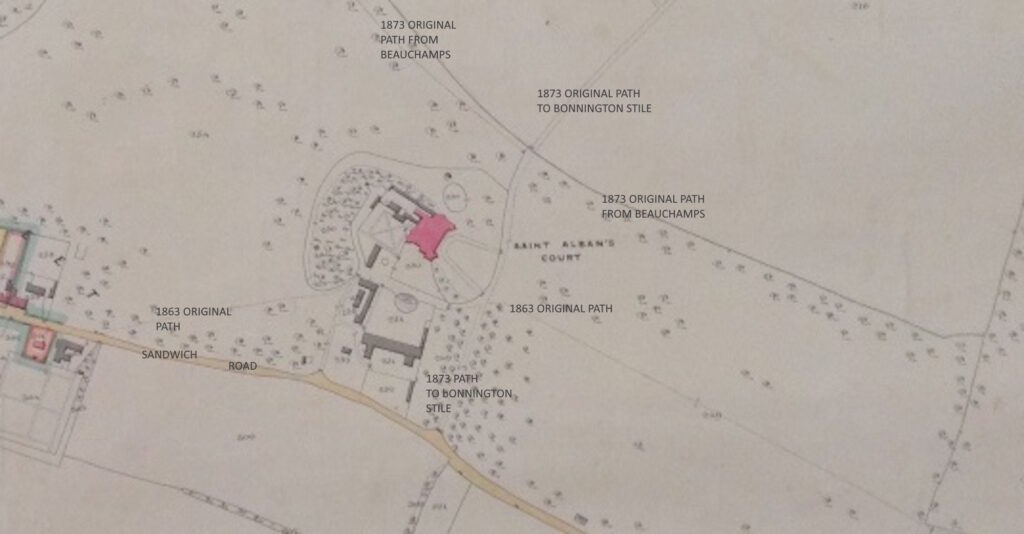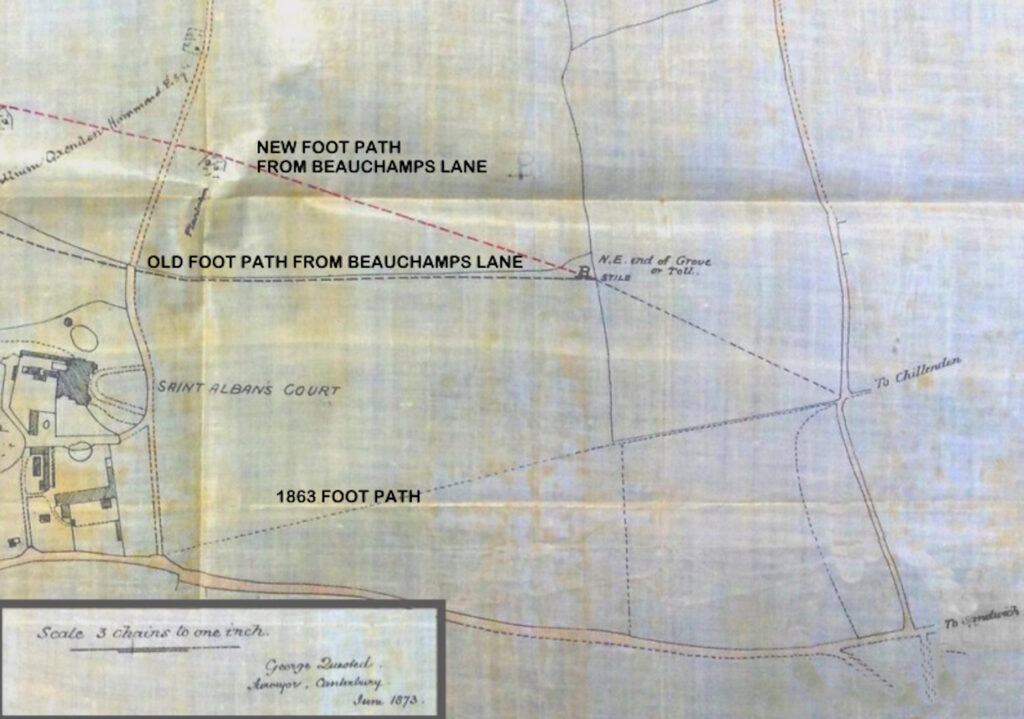Parish vestries were the predecessors of parish councils but had much more authority over parish affairs and finances. Nonington Parish Council held its inaugural meeting on 4th December, 1894.
At a Nonington Vestry meeting in early 1863 Mr William Oxenden Hammond of St. Alban’s Court in the parish of Nonington requested:
“to divert a certain footpath in Nonnington [sic] aforesaid leading out of Sandwich Road through a gate into the enclosure of St. Alban’s Court and opposite the kitchen Garden of the same towards Chillenden, that is to say, to a point where a style is placed midway between the mansion and the gate at Gooseberry Hall occupied by William Ellen, being a distance of 141 rods [a total of 775 ½ yards, a rod=5 ½ yards] so that the said footpath when diverted may lead from and out of the Sandwich Road aforesaid at and through the main entrance gate at St. Alban’s Court and may pass from thence across the pastureland obliquely until it unites with the present footpath at the stile aforesaid being in all a distance of 136 rods [a total of 748 yards] and being nearer than the present footpath”.
The diverted footpath began at the north-east corner of what is now Home Farm in Easole Street and went diagonally across the field in a northerly direction to pass through a gate into the kitchen gardens of the old St. Alban’s Court house and then on down the valley towards Chillenden.
Surveyor George Quested of Canterbury, who also made the 1859 Poor Law Commissioners map of Nonington, surveyed and drew up a map to accompany the application to divert the footpath, an extract of this map is shown below.
Over time the access from the Sandwich Road to this new footpath has moved fifty yards or so along the road and it is now designated by Kent County Council as a public footpath, reference EE308.

A section of Quested’s 1859 parish map showing St Alban’s Court and the footpaths before their diversions

Quested’s 1863 map showing the proposed diversion of the foot path

Old St. Alban’s Court house taken in the 1870’s. The path diverted in 1863 came from the left of the picture and out through the gate in the foreground and then towards Chillenden
~~~
Mr. Hammond’s application was then put before a meeting of the Highways Board of Wingham District on 8th May, 1863, where it was accepted and notice for diverting the path was signed and sealed at a later Board meeting on 25th June, 1863.
The Highways Act 1862 enabled justices of the peace of a county to divide the county into highway districts consisting of a number of parishes. This was done by means of a provisional order confirmed by the quarter sessions and this order listed the parishes to be grouped together into a highway’s board, the name to be given to the district and the number of waywardens to be elected by each parish. These highways boards took over responsibility from the parish vestries for the maintenance of the roads and the Wingham Board was responsible for fifty-two parishes. The highways boards were abolished and replaced by district councils in 1894.
William Oxenden Hammond of St. Alban’s Court was an original member of the Highways Board of Wingham District which held its inaugural meeting at The Red Lyon in Wingham on 13th April, 1863. Subsequent meetings were held in the Board Room at the Eastry Union House in Eastry.
Other founding members were: John Pembleton Plumtre of Fredville Park in Nonington; Sir Brooke W. Bridges, Bt., of Goodnestone Park; Admiral George H. De’Ath of Knowlton Court; Narborough De’Ath, Capt. George Sayer, R.N., and Capt. Rice, R.N., of Dane Court in Tilmanstone.
Waywardens elected to represent individual parishes adjacent to Nonington by Parish Vestries were: Nonington, Thomas Pepper, farmer of Curleswood Park Farm and a tenant of Sir Brooke Bridges; Barfrestone, John Harvey; Knowlton, G.S. Tapley; Chillenden, George Court, and Womenswold, Charles Ratcliffe.
Ten years later Mr. Hammond, who by this time had begun the construction of a new St. Alban’s Court mansion, applied to the Wingham Board to divert two more footpaths. The Wingham Board minutes of 24th July, 1873, show that W.O. Hammond applied to divert certain footpaths and the Nonington Parish Vestry minutes of the meeting held on 8th August 1873 record the proposal to divert two foot-paths around this new St. Alban’s Court mansion. One foot path lead from the Sandwich Road through the Avenue Gate to the west of the old St. Alban’s Court house going to what was then known as the Bonnington Stile and then to Goodnestone. Bonnington Stile would have been located at the northern end of Bonnington Shave, which forms a part of the boundary between the parishes of Nonington and Goodnestone. The site of the stile is still on the route of the diverted foot path, reference number EE218A, which was relocated to the south-west of the new St. Alban’s Court mansion.
The services of George Quested of Canterbury were again called upon to provide updated maps for Mr. Hammond’s proposed diversions. The map below shows the foot path to Bonnington Stile and Goodnestone running bottom to top in front of on the left side

The second path to be diverted was “a certain highway being a footpath leading from Church Street towards Chillenden”. The Church Street referred to is now known as Pinner’s Lane and Beauchamp’s Lane as far as the corner of Beauchamp’s Lane and the “certain highway being a foot path” is a section of an ancient track way, almost certainly in use in pre-Roman times. It leads in a north-easterly direction to Chillenden and then on to Eastry and Sandwich and in a south-westerly direction via Church Street in Nonington to Womenswold from where it goes into the Elham Valley and then to Lyminge and beyond.
A 1511 quitclaim for land in the parish of Nonington given by John Westclyve, a wealthy Sandwich merchant and later the town mayor, to John Langley, refers to “the highway from Sandwich to ‘le Weld’ [the Weald, as in the Weald of Kent]” as a land boundary.
This ancient track way was also a designated evacuation route for Nonington inhabitants to Lyminge in the event of a French invasion of East Kent during the Napoleonic Wars and a century later it was to be used to evacuate villagers in the event of a German invasion in the early part of the First World War.
This “certain highway being a footpath” was rerouted to the north-west side, the rear, of the new mansion house site and continued in use until fairly recently when it was closed and replaced by the present footpath EE306.

The two 1873 diversions were due to the building of the new St. Alban’s Court mansion in the mid-1870’s, the first path ran directly through the site of the new mansion and the second ran across the front of the site and users of the path would have been visible from the front rooms of the new house. The St. Alban’s cricket club ground which was in the valley in front of the old house and the home of the St. Alban’s Downs Cricket Club founded in 1847, was also closed and the cricket club relocated to its present ground in Fredville Park in 1877. Although the St. Alban’s Downs C.C. was founded in 1847 there are newspaper reports of earlier games being played at St. Alban’s Park between gentlemen from Nonington and similar teams from other Kent towns and villages.
Up to date information regarding public right of way in and around Nonington can be found on the KCC Public Rights of Way Map at https://webapps.kent.gov.uk/countrysideaccesscams/standardmap.aspx

